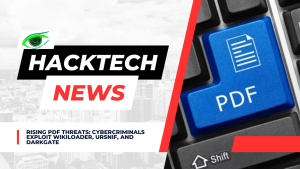
Rising PDF Threats: Cybercriminals In a recent report released by HP Wolf Security, alarming trends regarding PDF-based malware attacks have been uncovered. Cybercriminals are leveraging PDF documents as vectors to spread malicious software, with notable threats including WikiLoader, Ursnif, and DarkGate.
The analysis conducted by HP Wolf Security reveals a concerning 7% increase in PDF-based threats during the fourth quarter of 2023, compared to the first quarter of the same year. Previously, PDFs were primarily utilized in phishing attempts to extract sensitive information from unsuspecting victims. However, the landscape has evolved, with cybercriminals now employing PDFs as vehicles for malware dissemination.
Innovative Tactics Unveiled
The study highlights a significant shift in tactics, with 11% of the analyzed malware in Q4 2023 being delivered through PDFs, a substantial increase from the mere 4% observed in Q1. One prominent example cited in the report is a WikiLoader campaign, where cybercriminals utilized a counterfeit parcel delivery PDF to deceive users into installing Ursnif malware.
Ad Tools as Enablers
In a sophisticated DarkGate malware campaign, ad tools were instrumental in tracking victims and circumventing detection mechanisms. Malicious PDF attachments masquerading as OneDrive error messages entice users to sponsored content on a popular ad network. Upon clicking the link, unsuspecting individuals inadvertently download files containing DarkGate malware, compromising the security of their systems.
Evolution of Cyber Threats
Dr. Ian Pratt, Global Head of Security for Personal Systems at HP Inc., underscores the evolving nature of cyber threats, stating, “Cybercriminals are leveraging marketing campaign tools to optimize their malicious activities, increasing the success rate of their endeavors.” He emphasizes the importance of adopting zero-trust principles to mitigate risks associated with email attachments, links, and browser downloads.
Adaptive Strategies for Defense
To counter the evolving threat landscape, organizations are advised to implement adaptive defense strategies. Threat actors employ CAPTCHA tools to thwart sandbox scanning and ensure human interaction, underscoring the necessity for robust defense mechanisms. DarkGate, operating as a malware-as-a-service, poses significant risks, granting cybercriminals backdoor access to networks, potentially leading to data breaches and ransomware attacks.
Diversification of Attack Methods
Cybercriminals continue to diversify their tactics to evade security measures, with archives emerging as the preferred malware delivery method in 30% of analyzed incidents. RAR, ZIP, and GZ are identified as the top three malicious archive formats. Furthermore, a concerning 14% of email threats bypassed conventional gateway scanners, highlighting the need for enhanced email security measures.
Shift Towards Office Exploits
An intriguing shift from Macros to Office exploits is observed, with a majority of attempted intrusions leveraging vulnerabilities in spreadsheet and Word documents. Approximately 84% of spreadsheet-related intrusions and 73% of Word document-related intrusions sought to exploit vulnerabilities within Office applications.
In conclusion, the report sheds light on the escalating threat posed by PDF-based malware attacks, urging organizations to adopt proactive defense strategies to safeguard against evolving cyber threats. With cybercriminals constantly innovating their tactics, staying vigilant and implementing robust security measures is imperative in today’s digital landscape.
